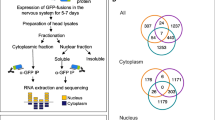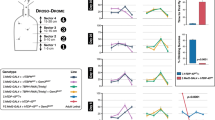Abstract
FHL1-related myopathies are rare X-linked dominant myopathies. Though clinically classified into several subgroups, spinal and scapuloperoneal muscle involvement are common to all. In this study, we identified c.449G > A, p.C150Y mutation by clinical exome sequencing in two patients from same family (son and mother) of Indian origin who presented with multiple contractures. Muscle biopsy showed numerous intracytoplasmic aggregates intensely stained on HE and MGT. The strong reactions to M-NBT revealed aggregates to be reducing bodies and positively labeled to anti-FHL1 antibody. Ultrastructurally, Z-band streaming and granular and granulofilamentous material were seen. Further, the translational evidence of mutant peptide was confirmed using mass spectrometric analysis. To establish p.C150Y as the cause for protein aggregation, in vivo studies were carried out using transgenic Drosophila model which highlighted Z-band abnormalities and protein aggregates in indirect flight muscles with compromised physiological function. Thus, recapitulating the X-linked human disease phenotype. Additionally, the molecular dynamics simulation analysis unraveled the drastic change in α-helix of LIM2, the region immediately next to site of C150Y mutation that could be the plausible cause for protein aggregation. To the best of our knowledge, this is the first study of p.C150Y mutation in FHL1 identified in Indian patients with in vivo and in silico analysis to establish the cause for protein aggregation in muscle.







Similar content being viewed by others
References
Brooke MH, Neville HE (1972) Reducing body myopathy. Neurology 22(8):829–840
Bowers KJ, Chow DE, Xu H, Dror RO, Eastwood MP, Gregersen BA, Klepeis JL, Kolossvary I, Moraes MA, & Sacerdoti FD (2006) Scalable algorithms for molecular dynamics simulations on commodity clusters. Paper presented at the SC'06: Proceedings of the 2006 ACM/IEEE Conference on Supercomputing
Brown S, McGrath MJ, LM Ooms, Gurung R, Maimone MM, Mitchell CA (1999) Characterization of two isoforms of the skeletal muscle LIM protein 1, SLIM1. Localization of SLIM1 at focal adhesions and the isoform slimmer in the nucleus of myoblasts and cytoplasm of myotubes suggests distinct roles in the cytoskeleton and in nuclear-cytoplasmic communication. J Biol Chem 274(38):27083–27091
Chen DH, Raskind WH, Parson WW, Sonnen JA, Vu T, Zheng Y, Matsushita M, Wolff J, Lipe H, Bird TD (2010) A novel mutation in FHL1 in a family with X-linked scapuloperoneal myopathy: phenotypic spectrum and structural study of FHL1 mutations. J Neurol Sci 296(1–2):22–29. https://doi.org/10.1016/j.jns.2010.06.017
Cowling BS, Cottle DL, Wilding BR, D’Arcy CE, Mitchell CA, McGrath MJ (2011) Four and a half LIM protein 1 gene mutations cause four distinct human myopathies: a comprehensive review of the clinical, histological and pathological features. Neuromuscul Disord 21(4):237–251. https://doi.org/10.1016/j.nmd.2011.01.001
Domenighetti AA, Chu PH, Wu T, Sheikh F, Gokhin DS, Guo LT, Cui Z, Peter AK, Christodoulou DC, Parfenov MG, Gorham JM, Li DY, Banerjee I, Lai X, Witzmann FA, Seidman CE, Seidman JG, Gomes AV, Shelton GD, Lieber RL, Chen J (2014) Loss of FHL1 induces an age-dependent skeletal muscle myopathy associated with myofibrillar and intermyofibrillar disorganization in mice. Hum Mol Genet 23(1):209–225. https://doi.org/10.1093/hmg/ddt412
Drummond DR, Hennessey ES, Sparrow JC (1991) Characterisation of missense mutations in the Act88F gene of Drosophila melanogaster. Mol Gen Genet 226(1–2):70–80. https://doi.org/10.1007/bf00273589
Figarella-Branger D, Putzu GA, Bouvier-Labit C, Pouget J, Chateau D, Fardeau M, Pellissier JF (1999) Adult onset reducing body myopathy. Neuromuscul Disord 9(8):580–586. https://doi.org/10.1016/s0960-8966(99)00058-9
Gregersen N (2006) Protein misfolding disorders: pathogenesis and intervention. J Inherit Metab Dis 29(2–3):456–470. https://doi.org/10.1007/s10545-006-0301-4
Gueneau L, Bertrand AT, Jais JP, Salih MA, Stojkovic T, Wehnert M, Hoeltzenbein M, Spuler S, Saitoh S, Verschueren A, Tranchant C, Beuvin M, Lacene E, Romero NB, Heath S, Zelenika D, Voit T, Eymard B, Ben Yaou R, Bonne G (2009) Mutations of the FHL1 gene cause Emery-Dreifuss muscular dystrophy. Am J Hum Genet 85(3):338–353. https://doi.org/10.1016/j.ajhg.2009.07.015
Hu Z, Zhu Y, Liu X, Zhang W, Liu J, Wu S, Xiao J, Yuan Y, Wang Z (2019) FHL1-related clinical, muscle MRI and genetic features in six Chinese patients with reducing body myopathy. J Hum Genet 64(9):919–926. https://doi.org/10.1038/s10038-019-0627-z
Kadrmas JL, Beckerle MC (2004) The LIM domain: from the cytoskeleton to the nucleus. Nat Rev Mol Cell Biol 5(11):920–931. https://doi.org/10.1038/nrm1499
Keßler M, Kieltsch A, Kayvanpour E, Katus HA, Schoser B, Schessl J, Just S, Rottbauer W (2018) A zebrafish model for FHL1-opathy reveals loss-of-function effects of human FHL1 mutations. Neuromuscul Disord 28(6):521–531. https://doi.org/10.1016/j.nmd.2018.03.001
Kiyomoto BH, Murakami N, Kobayashi Y, Nihei K, Tanaka T, Takeshita K, Nonaka I (1995) Fatal reducing body myopathy. Ultrastructural and immunohistochemical observations. J Neurol Sci 128(1):58–65
Kumar M, Varun CN, Dey G, Ravikumar R, Mahadevan A, Shankar SK, Prasad TSK (2018) Identification of host-response in cerebral malaria patients using quantitative proteomic analysis. PROTEOMICS – Clinical Applications 12(4):1600187. https://doi.org/10.1002/prca.201600187
O’Donnell PT, Bernstein SI (1988) Molecular and ultrastructural defects in a Drosophila myosin heavy chain mutant: differential effects on muscle function produced by similar thick filament abnormalities. J Cell Biol 107(6):2601–2612. https://doi.org/10.1083/jcb.107.6.2601
Ohsawa M, Liewluck T, Ogata K, Iizuka T, Hayashi Y, Nonaka I, Sasaki M, Nishino I (2007) Familial reducing body myopathy. Brain Develop 29(2):112–116. https://doi.org/10.1016/j.braindev.2006.06.010
Quinzii CM, Vu TH, Min KC, Tanji K, Barral S, Grewal RP, Kattah A, Camano P, Otaegui D, Kunimatsu T, Blake DM, Wilhelmsen KC, Rowland LP, Hays AP, Bonilla E, Hirano M (2008) X-linked dominant scapuloperoneal myopathy is due to a mutation in the gene encoding four-and-a-half-LIM protein 1. Am J Hum Genet 82(1):208–213. https://doi.org/10.1016/j.ajhg.2007.09.013
Ranganayakulu G, Schulz RA, Olson EN (1996) Wingless signaling induces nautilus expression in the ventral mesoderm of the Drosophila embryo. Dev Biol 176(1):143–148. https://doi.org/10.1006/dbio.1996.9987
Ross CA, Poirier MA (2004) Protein aggregation and neurodegenerative disease. Nat Med 10(Suppl):S10-17. https://doi.org/10.1038/nm1066
Sarkozy A, Windpassinger C, Hudson J, Dougan CF, Lecky B, Hilton-Jones D, Eagle M, Charlton R, Barresi R, Lochmüller H, Bushby K, Straub V (2011) Phenotypic heterogeneity in British patients with a founder mutation in the FHL1 gene. Eur J Hum Genet 19(10):1038–1044. https://doi.org/10.1038/ejhg.2011.84
Schessl J, Columbus A, Hu Y, Zou Y, Voit T, Goebel HH, Bonnemann CG (2010) Familial reducing body myopathy with cytoplasmic bodies and rigid spine revisited: identification of a second LIM domain mutation in FHL1. Neuropediatrics 41(1):43–46. https://doi.org/10.1055/s-0030-1254101
Schessl J, Zou Y, McGrath MJ, Cowling BS, Maiti B, Chin SS, Sewry C, Battini R, Hu Y, Cottle DL, Rosenblatt M, Spruce L, Ganguly A, Kirschner J, Judkins AR, Golden JA, Goebel HH, Muntoni F, Flanigan KM, Mitchell CA, Bönnemann CG (2008) Proteomic identification of FHL1 as the protein mutated in human reducing body myopathy. J Clin Invest 118(3):904–912. https://doi.org/10.1172/jci34450
Schoser B, Goebel HH, Janisch I, Quasthoff S, Rother J, Bergmann M, Muller-Felber W, Windpassinger C (2009) Consequences of mutations within the C terminus of the FHL1 gene. Neurology 73(7):543–551. https://doi.org/10.1212/WNL.0b013e3181b2a4b3
Shalaby S, Hayashi YK, Goto K, Ogawa M, Nonaka I, Noguchi S, Nishino I (2008) Rigid spine syndrome caused by a novel mutation in four-and-a-half LIM domain 1 gene (FHL1). Neuromuscul Disord 18(12):959–961. https://doi.org/10.1016/j.nmd.2008.09.012
Shalaby S, Hayashi YK, Nonaka I, Noguchi S, Nishino I (2009) Novel FHL1 mutations in fatal and benign reducing body myopathy. Neurology 72(4):375–376. https://doi.org/10.1212/01.wnl.0000341311.84347.a0
Shathasivam T, Kislinger T, Gramolini AO (2010) Genes, proteins and complexes: the multifaceted nature of FHL family proteins in diverse tissues. J Cell Mol Med 14(12):2702–2720. https://doi.org/10.1111/j.1582-4934.2010.01176.x
Spires-Jones TL, Attems J, Thal DR (2017) Interactions of pathological proteins in neurodegenerative diseases. Acta Neuropathol 134(2):187–205. https://doi.org/10.1007/s00401-017-1709-7
Windpassinger C, Schoser B, Straub V, Hochmeister S, Noor A, Lohberger B, Farra N, Petek E, Schwarzbraun T, Ofner L, Loscher WN, Wagner K, Lochmuller H, Vincent JB, Quasthoff S (2008) An X-linked myopathy with postural muscle atrophy and generalized hypertrophy, termed XMPMA, is caused by mutations in FHL1. Am J Hum Genet 82(1):88–99. https://doi.org/10.1016/j.ajhg.2007.09.004
Acknowledgments
We are thankful to the patients for participating in this study. We are also grateful to Dr. Carsten G. Bonnemann, NIH, USA, for providing FHL1 antibody.
Funding
The work was supported by the Department of Science and Technology (DST Ref No. F.NO.SR/SO/HS-103/2009/1(G)dated 8 Sept 2011), Government of India.
Author information
Authors and Affiliations
Corresponding author
Ethics declarations
Conflict of Interest
All the authors declare that there is no conflict of interest.
Ethical Approval
The study was approved by the Institute ethical committee (NIMHANS IEC NO. Sl.No.1, Clinical Neurosciences). Written informed consent was taken from patients prior to inclusion in the study.
Additional information
Publisher’s Note
Springer Nature remains neutral with regard to jurisdictional claims in published maps and institutional affiliations.
Supplementary Information
Below is the link to the electronic supplementary material.
Supplementary file1 (MPEG 4772 KB)
Supplementary file2 (MPEG 4642 KB)
Rights and permissions
About this article
Cite this article
Santhoshkumar, R., Preethish-Kumar, V., Mangalaparthi, K. et al. A Dominant C150Y Mutation in FHL1 Induces Structural Alterations in LIM2 Domain Causing Protein Aggregation In Human and Drosophila Indirect Flight Muscles. J Mol Neurosci 71, 2324–2335 (2021). https://doi.org/10.1007/s12031-020-01777-4
Received:
Accepted:
Published:
Issue Date:
DOI: https://doi.org/10.1007/s12031-020-01777-4




